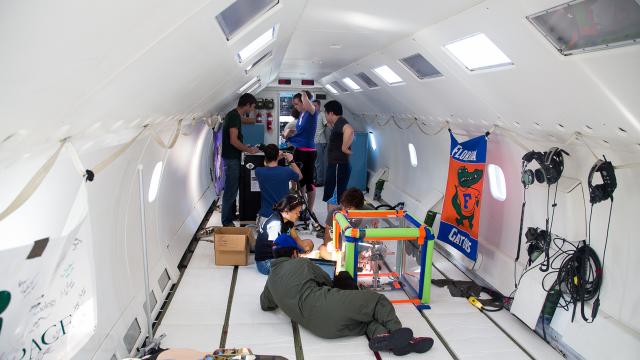How do you test a new method for CPR in space without actually going into space? You take flight in a microgravity plane, obviously. For the last 20 years, NASA’s Reduced Gravity Office has opened up its zero-g planes to college students from around the country, who get the once in a lifetime opportunity to test physical experiments in a weightless environment. Yes, they get to play with fire in zero g. Lucky…
This year Zach Barbeau, an engineering student from Oklahoma State University, reached out and asked if I’d like to ride along with his team.
I couldn’t have said yes fast enough. And it’s a good thing I did, because it’s possible that was the last hurrah for this beautiful and unique science program.
Microgravity University
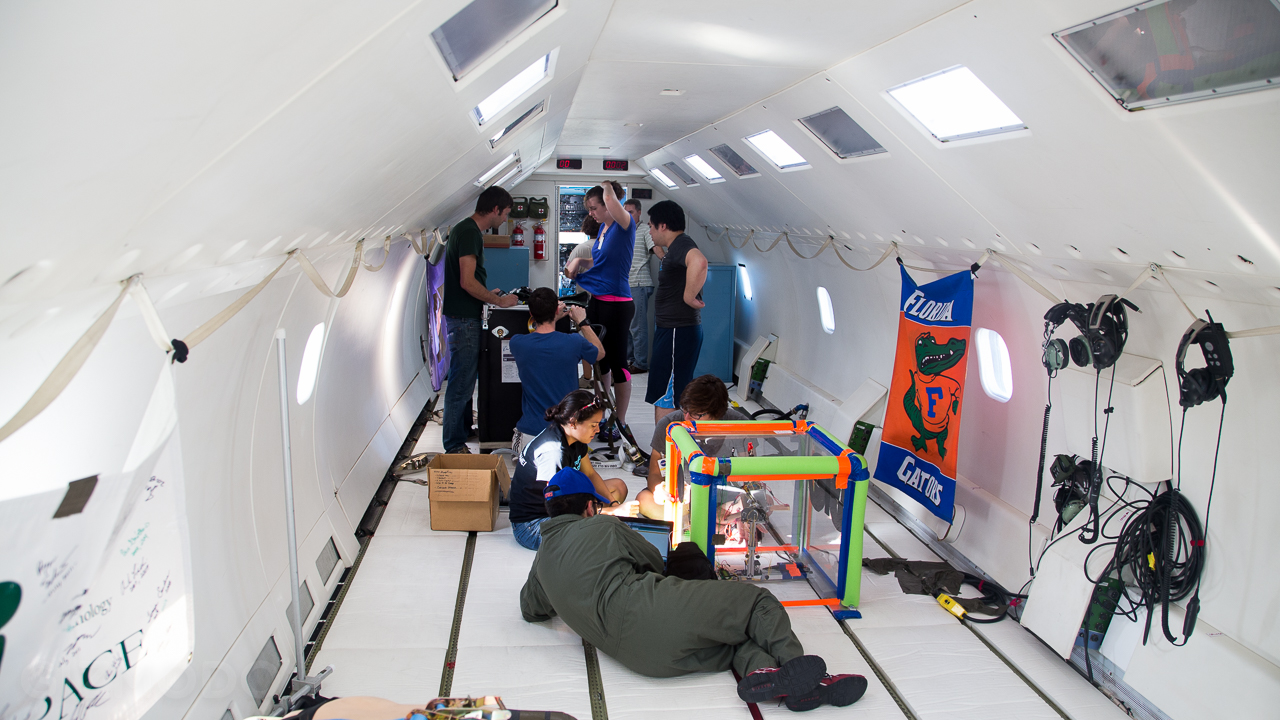
NASA’S Reduced Gravity Education Flight Program was founded in 1995, and every year since then every year it’s given students (and teachers) a chance to propose, design, build, test, and fly a microgravity experiment on a “Weightless Wonder” zero-G plane. This is how it earned the moniker Microgravity University. This year, the guidelines stipulated that the experiments focus on improving human spaceflight.
Students — mostly engineering students, but there are some exceptions — from universities all over the country form teams of six (five fliers plus one alternate) and submit project proposals to the space agency. We’re talking about solving major problems. Here’s are some of this year’s projects.
-
Our pals from Oklahoma State University (go Space Cowboys) were working on a dust mitigation experiment for near-Earth orbit missions. Did you know that space dust is basically like shards of glass? It’s so sharp that during the moon missions, it would eat through several layers of Kevlar on the astronauts’ suits. Kevlar!
The team wanted to see if creating an electric field would keep dust particles off of a surface in reduced gravity. That can’t be tested in Earth’s gravity, so this was the only platform (short of going into low-Earth orbit) on which they could test this theory.
- Missouri University was investigating a device that might improve CPR in zero gravity. (Remember “equal and opposite”? If you push on someone’s chest, you go flying in the other direction.)
- University of Nebraska-Lincoln was looking into a noninvasive biosensing capsule for long distance space flights. They put it in a pig intestine and built a device that simulates peristalsis.
- An all-female team from the University of Texas at Austin was studying how a new material called Vectran would burn in microgravity, which is especially important given that Bigelow Aerospace is using Vectran for its inflatable ISS module.
- Another all-female team from the University of Minnesota was studying functional apparel design; their experiment involved finding better wicking materials for the gloves on space suits.
- One school wanted to find the most convenient way to keep an object (a pen, in this case) in place in zero-g, and so they had a little box full of pens wedged into different materials, and it was filmed with a GoPro during flight. They found that a little sheet of soft rubber spikes offered the best combination of hold and ease of access.
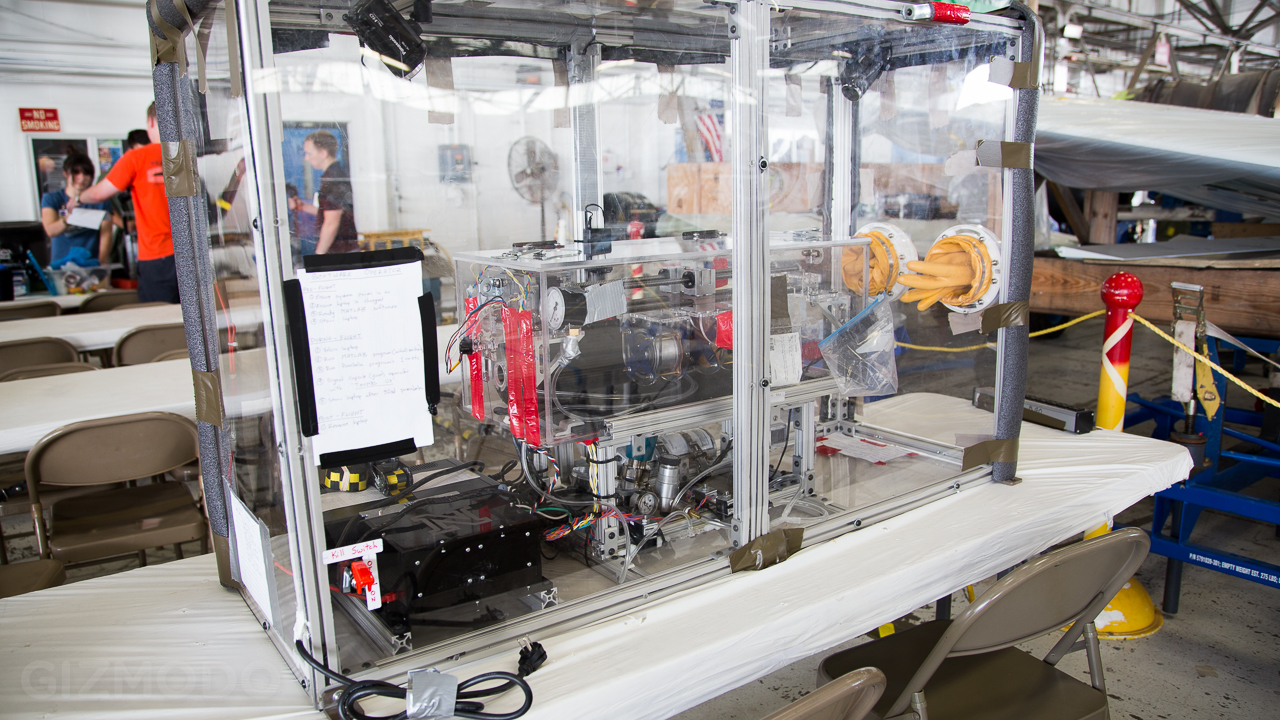
One team’s experiment, ready to be bolted to the Weightless Wonder
When the teams finally arrive at NASA for flight week, they have to defend their projects to upwards of 20 individual engineers and scientists. Some experiments must be rebuilt several times before they’re approved. Nobody sleeps very much.
What does that mean? The kids who are there, really want to be there, and they have absolutely worked their tails off to make it happen. I have never seen a group of young people so utterly thrilled to be doing some cold hard science. So many of them had dreams of careers in engineering and science, and it wasn’t just their dedication or work ethic that was inspiring, it was their passion.
The educational outreach being done at Microgravity University has real, tangible results; you could really see it light the fires under these young men and women. And hey, if NASA learns from the students’ discoveries (and they do, every time) it improves human space flight and increases the success rate for future missions. It’s a win-win.
Flying Science
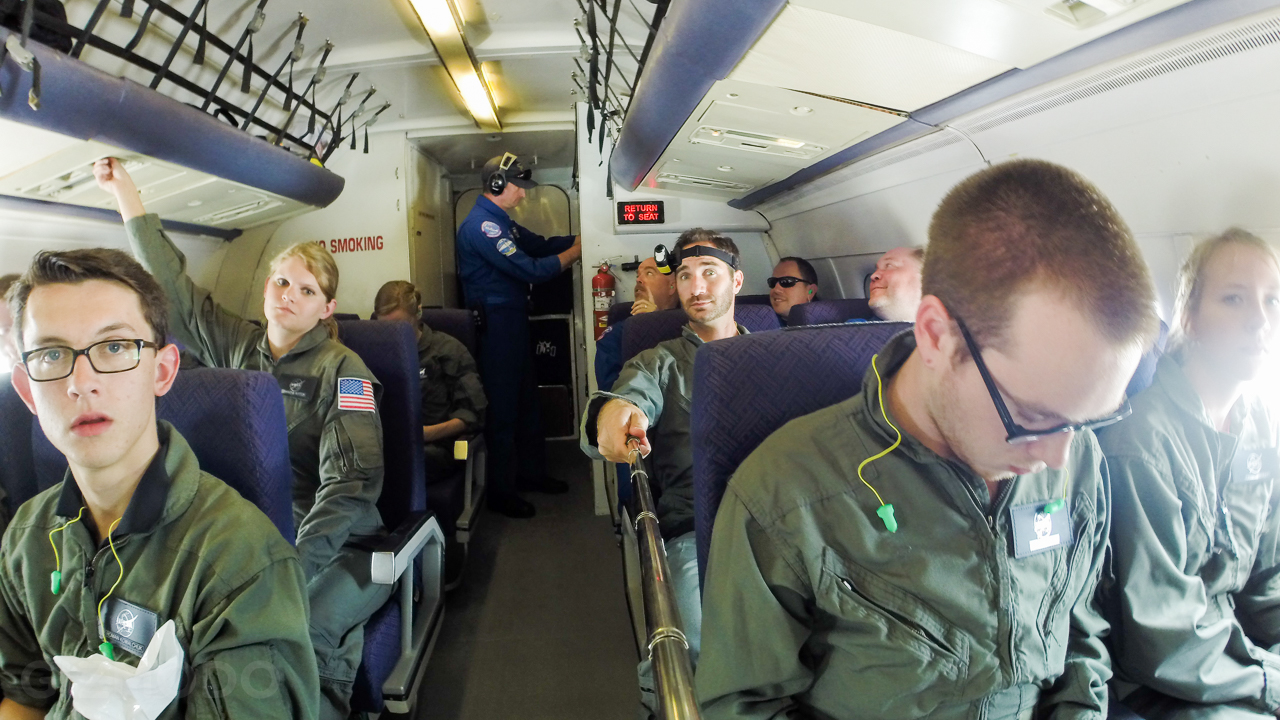
Once NASA’s officers have decided that the experiments are safe and (logically) sound, it’s time for them to fly. The morning of the flight, NASA’s crew loads the experiments into the plane and bolts them into the frame. Some projects are inside sealed housings that need to be connected to the plane’s exhaust system so they can vent smoke or potentially hazardous gasses. NASA’s Reduced Gravity office is equipped to handle all of that.
The students put on their flight suits, go through their medical briefing, have a final education and mission overview, and then they walk, single-file, into the belly of NASA’s C-9, dubbed the Weightless Wonder.
As I wrote all about earlier, flying on that plane was likely the single best experience of my entire life, thus far. It was thrilling and overwhelming, and yet these students buckled down and did their work like a group of professionals. They managed to enjoy themselves, but it was clear that their primary mission was the science.
I would float over to one team and then another, and they barely noticed me sticking my camera in their faces. They hand their hands on their experiments. They were reading data off their attached laptops. They were making sure their their cameras were rolling. Basically, they were on top of it.
Grounded
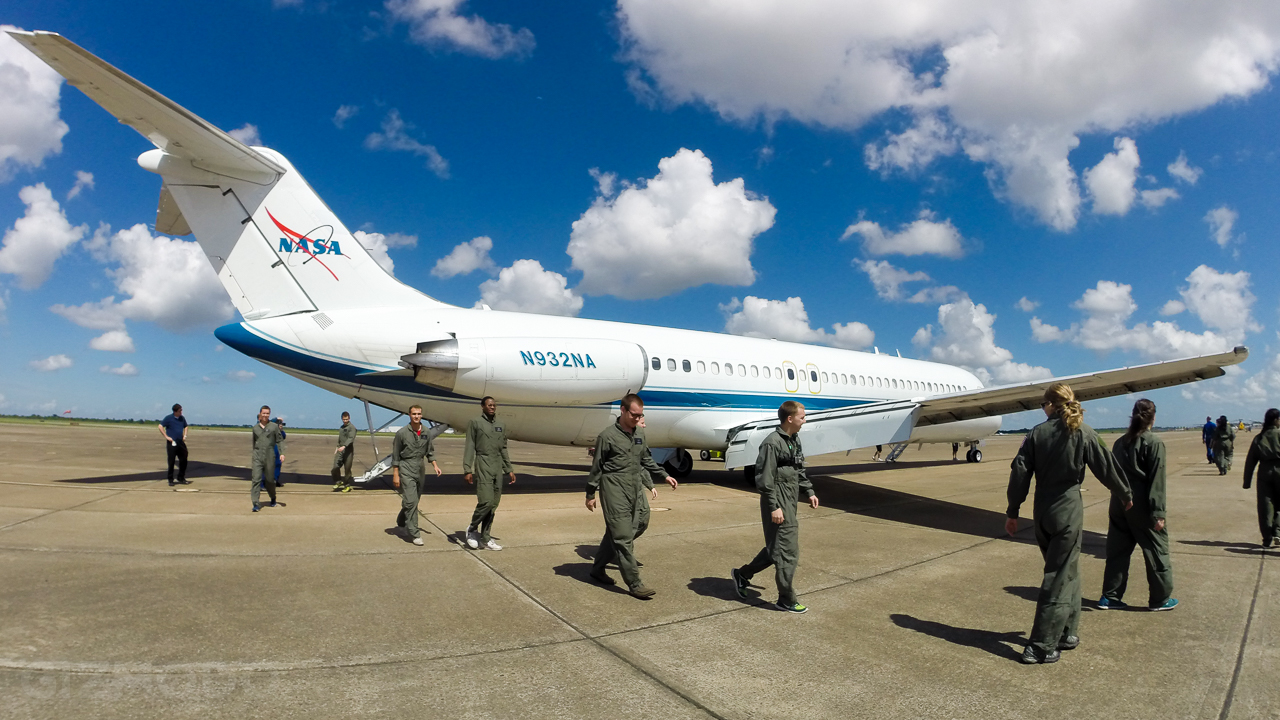
The Reduced Gravity Office lost funding and was officially disbanded in September 2014. This was a tragedy. It was the loss of a national capability. If we’re going to continue to send humans into space then we need the ability to test hardware and train in a microgravity environment. NASA’s scientists all knew that, but politicians were short-sighted and though NASA could just outsource its reduced gravity operations from a private contractor. The entire staff was reassigned to other office, the Weightless Wonder was decommissioned, and Microgravity University was grounded.
But then, in the 11th hour (or the 13th hour, really) NASA finally realised the need for parabolic flight operations and discovered that no commercial contractors were in a position to step up. It’s not simply a plane they need, it’s a laboratory that can fly. So, NASA has put out the call to get the office back up and running for at least another year (and likely longer).
Great news, right? Happy endings all around!
Well, unfortunately, even though the RGO is back, the Reduced Gravity Education Flight Program didn’t make it out unscathed.
When the Reduced Gravity Office was shuttered, the RGEFP was told there would be no more education microgravity flights because NASA didn’t have its own plane and staff for it. So with the resurrection of the program (and the Weightless Wonder) one would assume that they’d be back in business. Unfortunately, that’s not the case.
“The Office of Education budget for reduced gravity flights was allocated out to other education programs for FY2015,” Ann Marie Trotta, Public Affairs Officer for Education told us via email. “There are not any Office of Education-funded flights planned, nor does the Office of Education expect to schedule any flights in FY2015. We appreciate the value and appeal of these STEM flight experiences and hope to offer them again in the future.”
This is definitely disappointing, especially once you’ve seen the incredible impact it has on the students who participate. The Johnson Space Center still maintains the Microgravity University website and wanted to provide STEM students with unique and authentic NASA experiences; it just needed to find a new home for it. What it’s come up with is actually pretty cool.
Micro-G NExT

An astronaut trains in JSC’s Neutral Buoyancy Lab. Image courtesy of NASA
Starting next year, Microgravity University will be working with the space center’s Neutral Buoyancy Laboratory — essentially, a gigantic pool where astronauts train for spacewalks. It’s not the perfect analogue for microgravity that you get on the Weightless Wonder, but it’s close enough for a lot of testing and training, and it still sounds pretty sweet.
“The project is called Micro-G NExT (short for NBL Experiment Teams),” NASA Frank Prochaska told us in an exclusive interview. “NASA will provide basic requirements and University teams will design, build and travel with prototype hardware to the NBL to test. Students will get to design hardware for use in a microgravity environment and will get to contribute to future NASA hardware.”
The call for teams will be announced on microgravityuniversity.jsc.nasa.gov very soon, and it sounds like an amazing opportunity. That said, it sounds like Frank, Dom, and everybody else is hopeful that educational microgravity flights will resume in 2016. Obviously, there are still a lot of ifs, but in a perfect world both the RGO and the NBL programs could exist concurrently, giving more opportunities than ever before to students interested in science and technology.
We’ll be continuing to check in with these guys as things progress and change, but one thing is for certain, what NASA JSC is offering through the Reduced Gravity Education Flight Program is incredibly unique and undeniably valuable. We hope the powers that be will recognise it for the treasure that it is and nourish it accordingly.
Pictures: Brent Rose, edited by Nick Stango and Michael Hession
Gizmodo’s Space Camp is all about the under-explored side of NASA, from robotics to medicine to deep-space telescopes to art. All this week we’ll be coming at you direct from NASA’s Johnson Space Center in Houston, Texas, shedding a light on this amazing world. You can follow the whole series here.
Special thanks to everybody at NASA JSC for making this happen. The list of thank yous would take up pages, but for giving us access, and for being so generous with their time, we are extremely grateful to everyone there.
Space Camp® is a registered trademark/service of the US Space & Rocket Center. This article and subsequent postings have not been written or endorsed by the US Space & Rocket Center or Space Camp®. To visit the official space camp website, click here.
